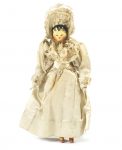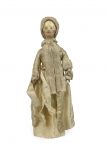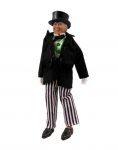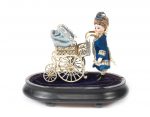Wooden dolls are probably some of the earliest examples of dolls. “Paddle Dolls” are some of the earliest, found in the tombs at Egypt. These “Paddle Dolls” were not likely to have been made for children but were more fertility items. Wooden dolls more likely to be collected by doll collectors are the wooden dolls often referred to as Dutch dolls.
Grodenertal carved wooden doll, circa 1840 With finely painted features, and black hair with painted curls and tuck-comb, peg-jointed at shoulders, elbows, hips and knees and having painted red slippers, wearing original ivory silk dress with fancy bonnet, 14cm (5 1/2in) tall.
Sold for £ 3,125 inc. premium at Bonhams in 2015
Wooden paddle doll; painted geometric decoration; hair represented by strings of mud-beads.
This type of figurine is made of a flat piece of wood, and the shape employed has given rise to the modern nickname of ‘paddle doll’. The body shape is very stylized, with a short stump of wood for the neck and the arms shown as rather short and lacking hands; the body terminates in an exaggerated depiction of the pubic region. The figure is painted with a collar in red and yellow round the neck, and the body is covered by a low-backed dress with shoulder straps, decorated in a geometric pattern of red, yellow, and black. It has been suggested that the patterns used on this object and others like it are inspired by Nubian dress. The head is made separately, from cloth wrapped around the wooden stump and then shaped and painted black, with two small objects, probably beads, representing the eyes. The impressive head of hair is composed of a number of small disc beads made of unfired mud, strung and attached to the head. Most objects of this type come from Upper Egypt, and are of early Middle Kingdom date; examples are particularly numerous at Thebes.
Reference: © The Trustees of the British Museum
A VERY RARE GEORGE II TURNED WOOD BABY DOLL MID-18TH CENTURY In original robes of the period, in inlaid wooden box with sliding lid and label on underside 5½ in. (14 cm.) high
A VERY RARE GEORGE II TURNED WOOD BABY DOLL MID-18TH CENTURY In original robes of the period, in inlaid wooden box with sliding lid and label on underside 5½ in. (14 cm.) high
Sold for GBP 5,250 at Christies in 2009
An early 19th century carved wooden and gesso doll, the carved head with painted facial details and inset eyes, the body originally fitted with wooden legs and stitched fabric arms (now missing), 10.75 (27.25cm) tall. CONDITION Damaged and incomplete, wear and losses to paint and gesso, major loss to nose.
Sold for £1,400 at Fellows in 2018
Peg doll comprising a wooden body and a painted face showing dark eyes, red cheeks and a closed, red painted mouth. The doll is dressed in working class, possibly a servant’s costume. The hair is drawn tightly back around the face with spit curls at the ears and a carved, yellow hair comb protruding from the top of the head. The arms are straight by the doll’s side with spade shaped hands and the legs are also straight. The doll is dressed in calico bloomers, a plaint white cotton petticoat, red flannel petticoat, long jacket of mauve cotton with an all-over printed pattern of fern leaves, a white neck cloth, gathered black skirt with a tie at the back, a blue and white gingham apron and long, green knitted stockings held in place with string, to form a garter. The doll also wears a pair of fine black kid shoes which are laced at the front. Accompanying the doll is a turned wooden stand, a gingham cap and a black, close fitting bonnet.
This doll belonged to Emily Elizabeth Norton (b 1848), the daughter of James Norton and his second wife Marion
The doll is a reminder of how some children treasured their toys and carefully preserved them throughout their lives. Despite Emily Norton’s long and often peripatetic life she kept Polly Oliver in almost her original condition. The doll’s clothes would either have been original or made by Emily or a member of her family shortly after she was purchased.
Reference: Museum of Applied Art and Sciences
English wooden doll called ‘Benny’, dressed as a boy in a jacket, short trousers and shirt circa 1903
The doll was a present for Ethel Alice Mundy (08/01/1897-17/03/1988) on her 6th birthday. Her father Levi Mundy made the doll, and her mother Elizabeth Mundy dressed it. Although the outfit appears masculine, the jacket and shirt button right over left, as for a female; the doll itself has a torso of more male proportions but a head which could equally well represent a female
Reference: © Victoria and Albert Museum







